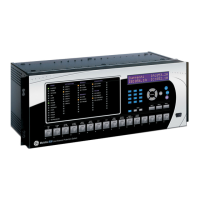5-192 D30 LINE DISTANCE PROTECTION SYSTEM – INSTRUCTION MANUAL
GROUPED ELEMENTS CHAPTER 5: SETTINGS
5
The following common settings are available for distance protection.
The
DISTANCE SOURCE identifies the signal source for all distance functions. The mho distance functions use a dynamic
characteristic; the positive-sequence voltage—either memorized or actual—is used as a polarizing signal. The memory
voltage is also used by the built-in directional supervising functions applied for both the mho and quad characteristics.
The
MEMORY DURATION setting specifies the length of time that a memorized positive-sequence voltage is used in the
distance calculations. After this interval expires, the relay checks the magnitude of the actual positive-sequence voltage. If
it is higher than 10% of the nominal, the actual voltage is used, and if lower the memory voltage continues to be used.
The memory is established when the positive-sequence voltage stays above 80% of its nominal value for five power
system cycles. For this reason, it is important to ensure that the nominal secondary voltage of the VT is entered correctly
under the
SETTINGS SYSTEM SETUP AC INPUTS VOLTAGE BANK menu.
Set
MEMORY DURATION long enough to ensure stability on close-in reverse three-phase faults. For this purpose, consider the
maximum fault clearing time (breaker fail time) in the substation. On the other hand, the
MEMORY DURATION cannot be too
long as the power system can experience power swing conditions rotating the voltage and current phasors slowly while
the memory voltage is static, as frozen at the beginning of the fault. Keeping the memory in effect for too long can
eventually lead to incorrect operation of the distance functions.
The distance zones can be forced to become self-polarized through the
FORCE SELF-POLAR setting. Any user-selected
condition (any FlexLogic operand) can be configured to force self-polarization. When the selected operand is asserted
(logic 1), the distance functions become self-polarized regardless of other memory voltage logic conditions. When the
selected operand is de-asserted (logic 0), the distance functions follow other conditions of the memory voltage logic as
shown in the following logic diagram.
The distance zones can be forced to become memory-polarized through the
FORCE MEM-POLAR setting. Any user-selected
condition (any FlexLogic operand) can be configured to force memory polarization. When the selected operand is asserted
(logic 1), the distance functions become memory-polarized regardless of the positive-sequence voltage magnitude at this
time. When the selected operand is de-asserted (logic 0), the distance functions follow other conditions of the memory
voltage logic.
Never let the
FORCE SELF-POLAR and FORCE MEM-POLAR settings to be asserted simultaneously. If this happens, the logic
gives higher priority to forcing self-polarization as indicated in the logic diagram. This is consistent with the overall
philosophy of distance memory polarization.
FAST DISTANCE enables the fast distance algorithm in phase and ground zone 1 and zone 2. Disable fast distance for
distance protection applications on a series compensated line.
FORCE MEM-POLAR:
Off
Range: FlexLogic operand
FAST DISTANCE:
Enabled
Range: Disabled, Enabled
PH DIST PH SELECT
SUPV: Enabled
Range: Disabled, Enabled
PHASE DISTANCE Z1
See page 5-193
PHASE DISTANCE Z5
GROUND DISTANCE Z1
See page 5-203
GROUND DISTANCE Z5
The memory polarization cannot be applied permanently but for a limited time only. The self-polarization can be
applied permanently and therefore takes higher priority.

